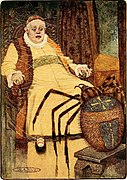The princess and Curdie
The Princess and Curdie (original title: The Princess and Curdie ) is a fantasy - novel of the Scottish author George MacDonald from 1883. This is a continuation of his eleven years previously published work The Princess and the Goblin . Both books together are referred to as Princess Books or Curdie Books in English-language literature .
action
A year has passed since the goblins attacked the royal palace. The king decides to move to his palace in the capital, Gwyntystorm, with his daughter, Princess Irene. The 13-year-old miner's son Curdie Peterson, who had won the favor of the king with his courage, prefers to stay with his parents. In the course of time, Curdie's belief in the mysterious great-great-grandmother of the princess fades and he takes pleasure in the hunt . One day he ruthlessly injures one of the grandmother's pigeons with his bow , whereupon she calls the boy to her. Curdie appears refined and receives a mission from the old lady. She equips him with magical hands that enable him to grasp the essence of his fellow human beings. She also puts a four-legged creature named Lina at his side and gives his father an emerald that changes color as soon as Curdie is in danger.
Curdie and Lina make their way to Gwyntystorm. During the trip, Lina saves the young miner from one or the other evil and thus proves to be a loyal companion. Arrived at the royal palace, you find the king in terrible health. Princess Irene takes care of her father on the sickbed. Curdie learns that the personal physician is slowly poisoning the king instead of helping him. The other court servants are also part of a conspiracy against the regent, which aims to marry Irene to a selected heir to the throne as soon as her father is dead. With the help of the great-great-grandmother, who disguises herself as a maid , the plot is broken up. Curdie later marries the princess and ruled the kingdom magnanimously after the death of his father-in-law. The marriage, however, remains childless, and Curdie is followed by a gold-greedy despot who plunges the city into ruin. The name Gwyntystorm was then forever forgotten.
Illustrations
The original edition was published by JB Lippincott & Co. in 1883 and was illustrated by James Allen. Probably the most famous illustrations were made by Maria Louise Kirk for a new edition of the book in 1908.
- Maria Louise Kirk (1908)
reception
The Princess and Curdie was first published in Good Things magazine five years after The Princess and the Goblin and was published in book form in 1883. In contrast to the first work, a clear civilization pessimism is expressed. MacDonald designs - inspired by William Blake - a gloomy image of society, the end of which looks like the biblical apocalypse . He remains true to his Christian symbolism around the mystical grandmother figure, established in the first novel .
The book is considered a classic of children's and youth literature , especially in combination with its predecessor , but is mostly received much less positively. The well-known writer and journalist Lynne Truss reflected in the Independent in 2009 on her experiences with the book she was given on her seventh birthday. She called it "dark, dense and moralistic ". The studied writer Rebecca Fisher felt the plot line of the conspiracy against the king for the late 19th century as outdated and criticized the lack of character development of Lina and other characters. She also criticized the, in her opinion, unchristian vengeance motif at the end of the story, which was accompanied by sentences like "they were smeared with rancid dripping, their faces were rubbed in maggots" ) would be portrayed with an almost sadistic joy.
literature
- Humphrey Carpenter : George MacDonald and the Tender Grandmother. In: Secret Gardens: A Study of the Golden Age of Children's Literature , London 1985, ISBN 978-0571249145 , pp. 70-85 (English).
- Maria Gonzalez Davies: A Spiritual Presence in Fairyland: The Great-Great Grandmother in the Princess Books. In: North Wind: A Journal of George MacDonald Studies Volume 12 (1993), pp. 60-65. Online , accessed March 31, 2019.
- Mary Kirkpatrick: An Introduction to the Curdie Books by George MacDonald including Parallels between Them and the Narnia Chronicles. In: CSL: The Bulletin of the New York CS Lewis Society 5 (1974), pp. 1-6.
- Michael C. Kotzin: CS Lewis and George MacDonald: The Silver Chair and the Princess Books. In: Mythlore 8 (1981), pp. 5-15 (English).
- Roderick McGillis: George MacDonald's "Princess" Books: High Seriousness. In: Perry Nodelman (Ed.): Touchstones. Reflections on the Best in Children's Literature. Volume 1, West Lafayette 1985, ISBN, pp. 146-162 (English).
- Joseph Sigman: The Diamond in the Ashes: A Jungian Reading of the Princess Books. In: Roderick McGillis (Ed.): For the Childlike. George MacDonald's Fantasies for Children. Metuchen 1992, ISBN 978-0810824591 , pp. 161-168 (English).
- E. Sparks: "The Princess and the Goblin" and "The Princess and Curdie". In: FN Magill (Ed.): Survey of Modern Fantasy Literature. Volume 3, Englewood Cliffs 1983, pp. 1280-1285 (English).
Web links
- The Princess and Curdie in Project Gutenberg ( currently usually not available for users from Germany )
- Audiobook at LibriVox
Individual evidence
- ^ Bettina Kümmerling-Meibauer: Classics of children's and youth literature. An international lexicon. JB Metzler , Stuttgart 1999, ISBN 978-3-476-01235-7 , pp. 669-671. Google preview , accessed May 17, 2019.
- ↑ Lynne Truss : Book Of A Lifetime: The Princess and the Curdie, By George MacDonald. October 9, 2009, accessed May 17, 2019 .
- ↑ Rebecca Fisher: The Princess and Curdie: Give it a miss. Fantasy Literature, accessed May 17, 2019 .






